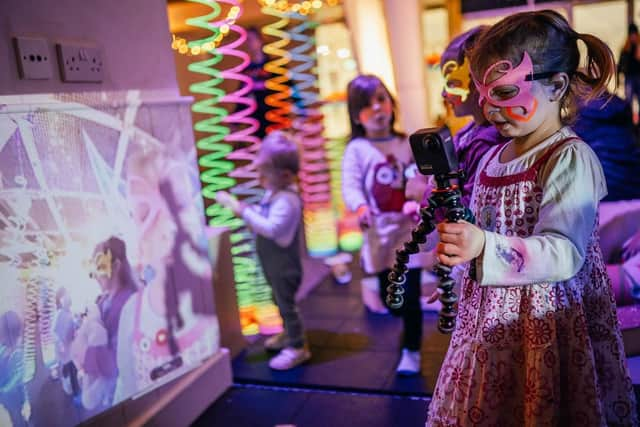The Starcatchers Baby Studio: ‘High-level art is for all ages’
“This is a yes space,” says performer Kerry Cleland. We are surveying the scene in the Baby Studio in Wester Hailes, a place where there is no wrong way to behave. Anything goes in this new base for Starcatchers, the arts and early-years organisation.
You will find it in a previously empty unit in the Westside Plaza shopping centre. It is near the foot of the escalators, along from the post office and opposite the opticians. The location sends an important message: everyone is welcome.
Advertisement
Hide AdGive the Baby Studio a casual glance and you might think you were in any play centre. There are cushioned building blocks, toddlers in every direction and parents chatting in the corner. Look more closely, however, and you see something else is going on.


A babe in arms is held rapt by a giant slinky in Day-Glo colours hanging from the ceiling. A two year old is slapping an enormous sheet of orange gel to create a thunderous racket. The quieter children are moving shapes on an overhead projector to create patterns on a sheet hanging from a washing line.
The more boisterous are engaged in a two-way exchange with dancer KJ Clarke-Davis, twirling, crouching and bouncing around the space. Those with crayons can have a go at the paper pinned up on the wall.
Adults would describe this activity with phrases like improvised choreography, kinetic sculpture and abstract art, but for the under-fives, it’s all one big sensory experience. They don’t distinguish between performance and participation, or between one genre and another. Neither does Starcatchers.
“High-level art is for all ages,” says Cleland, one of the company’s lead artists in Wester Hailes. “This is the most important audience and also the most honest. They’ll tell you when they don’t like it! I learn from the babies about how to be open, to listen and to respond.”
Fellow lead artist Katy Wilson has been watching Clarke-Davis dance and uses him as a case in point. “He was taking ideas from the kids,” she says. “They are so open. We have a lot of artists coming in, so there is a lot of inspiration – different brains and different ways of thinking from visual artists, musicians and performers, providing fuel for all ages.”
Advertisement
Hide AdSince its foundation in 2006, Starcatchers has learned to accept that very young audiences want to be hands-on. “Sometimes they do want to watch a show, but a lot of the time they want to be part of it,” says Wilson. “We can make that happen by taking their lead.”
For the time being, the studio is primarily open at weekends for free, artist-facilitated creative play sessions at Starcatchers Saturdays. The company will also use the space to develop performances in conjunction with young audiences. There will be some pop-up play events on other days and, if funding allowed, the company would like to open more frequently. “We know the impact that access to the arts has on young lives, and the lives of their whole family,” says chief executive Rhona Matheson. “We see the evidence of this through the work we do across communities in Scotland. Securing a unit in the local shopping centre allows us to reach the community in a targeted way, creating an equitable, accessible artistic experience.”
Advertisement
Hide AdThe Baby Studio has been made possible by Outer Spaces, a charity that takes on vacant commercial properties for artists on a temporary basis. The beneficiaries are not only the under-fives. “We aim for parent engagement,” says Cleland. “We want everyone down at floor level and playing, so the adults can find their playful selves and connect with their child.”
Wilson adds: “The children are creating something that is good for the mental health of both of them. They can have such a good time together. That’s what we’re doing: creating good times.”
The parents think so too. “This is a really good place for him to interact,” says mum Laura, while her two-year-old son is away exploring. “He loves it. Every week, when they’re growing and developing, you can see them engaging more and more.”
The effects are long-lasting. “He’ll try things for the first time here and we’ll do it again at home,” she says. “It’s good for giving you ideas – simple but effective things.”
Laura’s friend Rachel agrees. “It definitely gives me the confidence to try more things at home,” she says. “Something as simple as having a metal colander and the play of the lights coming through it. They’ve done a lot of music here and I’ve been pulling out the filing cabinets and pans and he’ll turn them into drums. He’s really engaged with it.”
Rachel’s son is 19 months old and busy on the other side of the room. She appreciates how the activities respond to what he is interested in. “They’ll have a theme, but they let the kids interact with it how they want,” she says. “There’s a slight bit of structure but then it’s very free-flow and imaginative. They bring in all the expertise from the performance side and then let the kids and babies interact with it how they choose. It’s like a giant sensory playroom geared to the babies.”
Advertisement
Hide AdArt might be the motivation, but the benefits are widely felt. GP practices, health visitors and social workers have all referred families to Starcatchers. They are thinking about more than the children. “Starcatchers look out for the mums as well,” says Rachel. “They’re always double-checking how you’re doing. I can come in feeling really down and sad, chasing after kids all the time, and I can leave with a smile on my face.”
For more information, see www.starcatchers.org.uk